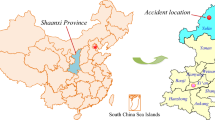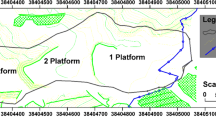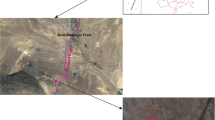Abstract
Coal fires are global disasters, and China suffers the most serious coal fire disasters in the world. This paper introduces detailed detection and extinguishing methods for the wide range and complex coal fires at the No. 1 well in the Fukang mining area. First, the characteristics of the large and complex coal fire areas in the No. 1 well in the Fukang mining area are introduced, and 5 large fire areas are detected using the comprehensive detection range method, which detects fire areas before fire engineering practices are implemented. From the characteristics of this large-scale, complex coal fire, the zonal fire extinguishing scheme is formulated, designed, and applied, and the “shallow open fire stripping—construction of the boundary isolation zone—drilling and grouting in the deep fire area” series of events is utilized in the zonal fire extinguishing scheme. A new type of sodium silicate gel in compressive moisturizing plastic packing materials is used, an automatic grouting system is developed, and effective grouting processes are proposed, which can be adjusted according to the grouting effect analysis of the grouting parameters to determine the natural sedimentation and diffusion radius. After the construction was completed, the fire extinguishing effect was tested, revealing that the temperature in the fire zone cooled in a short time, and no subsequent heating phenomenon occurs. The method proposed in this paper provides guidance and a reference for other coal fires in the world.



















Similar content being viewed by others
References
BP (2018) (2018) BP Statistical Review of World Energy
Cao D, Shi X (2009) Comprehensive evaluation index system and evaluation method of environmental impact in coal field and fire area. J Earth Sci Environ 31:94–99
Dai S, Ren D, Chou CL, Finkelman RB, Seredin VV, Zhou Y (2012) Geochemistry of trace elements in Chinese coals: a review of abundances, genetic types, impacts on human health, and industrial utilization. Int J Coal Geol 94:3–21
Dijk PV, Zhang J, Wang J, Kuenzer C, Wolf KH (2011) Assessment of the contribution of in-situ combustion of coal to greenhouse gas emission; based on a comparison of Chinese mining information to previous remote sensing estimates. Int J Coal Geol 86:108–119
Finkelman RB (2004) Potential health impacts of burning coal beds and waste banks. Int J Coal Geol 59:19–24
Kong B, Li Z, Yang Y, Liu Z, Yan D (2017) A review on the mechanism, risk evaluation, and prevention of coal spontaneous combustion in China. Environ Sci Pollut Res 24:1–18
Kuenzer C, Stracher GB (2012) Geomorphology of coal seam fires. Geomorphology 138:209–222
Kuenzer C, Zhang J, Tetzlaff A, van Dijk P, Voigt S, Mehl H, Wagner W (2007) Uncontrolled coal fires and their environmental impacts: investigating two arid mining regions in north-central China. Appl Geogr 27:42–62
Li Z, Kong B, Wei A, Yang Y, Zhou Y, Zhang L (2016) Free radical reaction characteristics of coal low-temperature oxidation and its inhibition method. Environ Sci Pollut Res 23:23593–23605
Liang Y, Liang H, Zhu S, Liang Y, Liang H, Zhu S (2014) Mercury emission from coal seam fire at Wuda, Inner Mongolia, China. Atmos Environ 83:176–184
Liu Z, Wang W (2017) Application of instantaneous measurement of radon in the detection of hidden fire sources in small coal pits. Coal Mine Saf 48:148–154
Liu W, Qin Y, Yang X, Wang W, Chen Y (2018) Early extinguishment of spontaneous combustion of coal underground by using dry-ice’s rapid sublimation: a case study of application. Fuel 217:544–552
Rúa MOB, Baena PB, Aragón AJD (2018) Optimization of techniques for the extinction and prevention of coal fires produced in final walls as a result of spontaneous combustion in the Cerrejón mine—Colombia. Environ Sci Pollut Res 25:32515–32523
Shao Z, Wang D, Wang Y, Zhong X, Tang X, Hu X (2015) Controlling coal fires using the three-phase foam and water mist techniques in the Anjialing Open Pit Mine, China. Nat Hazards 75:1833–1852
Shao Z, Jia X, Zhong X, Wang D, Wei J, Wang Y, Chen L (2018) Detection, extinguishing, and monitoring of a coal fire in Xinjiang, China. Environ Sci Pollut Res 25:26603–26616
Song Z, Kuenzer C (2014) Coal fires in China over the last decade: a comprehensive review. Int J Coal Geol 133:72–99
Song Z, Kuenzer C (2017) Spectral reflectance (400–2500 nm) properties of coals, adjacent sediments, metamorphic and pyrometamorphic rocks in coal-fire areas: a case study of Wuda coalfield and its surrounding areas, northern China. Int J Coal Geol 171:142–152
Song Z, Zhu H, Bo T, Wang H, Qin X (2014) Numerical study on effects of air leakages from abandoned galleries on hill-side coal fires. Fire Saf J 69:99–110
Song Z, Kuenzer C, Zhu H, Zhen Z, Jia Y, Sun Y, Zhang J (2015) Analysis of coal fire dynamics in the Wuda syncline impacted by fire-fighting activities based on in-situ observations and Landsat-8 remote sensing data. Int J Coal Geol 141-142:91–102
Song Z, Wu D, Jiang J, Pan X (2019) Thermo-solutal buoyancy driven air flow through thermally decomposed thin porous media in a U-shaped channel: towards understanding persistent underground coal fires. Appl Therm Eng 159:113948
Stracher GB (2004) Coal fires burning around the world: a global catastrophe. Int J Coal Geol 59:1–6
Stracher GB, Prakash A, Sokol EV, Stracher GB, Prakash A, Sokol EV (2013) Preface to volume 1 - Coal and peat fires: a global perspective. Coal & Peat Fires A Global Perspective, pp vii–viii
Wang K (2013). Experimental study on oxidative spontaneous combustion of Jurassic coal in northern Shanxi. Xi’an University of Science and Technology
Wang K, Wei LU, Yunfeng DU, Zhang Q, Jun XU (2016) Study on plastic water glass gel for preventing coal spontaneous combustion. Min Saf Environ Prot 43:8–11
Xue S, Dickson B, Wu J (2008) Application of Rn technique to locate subsurface coal heatings in Australian coal mines. Int J Coal Geol 74:139–144
Zeng Q, Tiyip T, Wuttke MW, Guan WM (2015) Modeling of the equivalent permeability for an underground coal fire zone, Xinjiang region, China. Nat Hazards 78:957–971
Zhang J (2008) Research and control of underground coal fire in China. Coal industry Press
Acknowledgments
We appreciate the editor’s efforts and those of the anonymous reviewers who provided valuable comments and suggestions for our research.
Funding
This work was financially supported by the National Key Research and Development Program of China (2016YFC0801800) and the Beijing Natural Science Foundation (2174084), as well as the National Nature Science Foundation of China (51774291, 51864045).
Author information
Authors and Affiliations
Corresponding author
Additional information
Responsible editor: Philippe Garrigues
Publisher’s note
Springer Nature remains neutral with regard to jurisdictional claims in published maps and institutional affiliations.
Rights and permissions
About this article
Cite this article
Tan, B., Zhang, F., Zhang, Q. et al. Firefighting of subsurface coal fires with comprehensive techniques for detection and control: a case study of the Fukang coal fire in the Xinjiang region of China. Environ Sci Pollut Res 26, 29570–29584 (2019). https://doi.org/10.1007/s11356-019-06129-3
Received:
Accepted:
Published:
Issue Date:
DOI: https://doi.org/10.1007/s11356-019-06129-3




